David Simpson embarked on his journey in the realm of visual effects at Framestore back in 2008. Since then, he worked on Gravity, Fantastic Beasts and Where to Find Them, Thor: Ragnarok and His Dark Materials.
What is your background?
I studied Film Production at the Arts Institute in Bournemouth. After graduation one of my classmates secured an internship with Framestore. Luckily for me, he really impressed. I was invited to interview off the back of his hard work! I started in Paint & Roto and worked my way through the ranks.
How was this new collaboration Director Alex Garland?
Really fantastic. I think it’s turned out great and I’m so thankful to be a part of it. It was an enjoyable project – but that’s not to say it was easy. It was a lot of hard work and took a delicate hand.
Civil War always needed VFX (there are some things you just can’t film) but simultaneously those VFX needed to feel natural and grounded. The style was almost documentary – anything too Hollywood, or showy, would detract from the experience. We spent a lot of time dialling that in and finding the balance between scale and realism.
I think Alex uses VFX in a very artful way – it’s considered and restrained. He has a great eye and a pragmatic mind. When you work with Alex he wants every department to be involved in the creative process. He’ll listen to and consider any idea, wherever it comes from. It’s very collaborative.
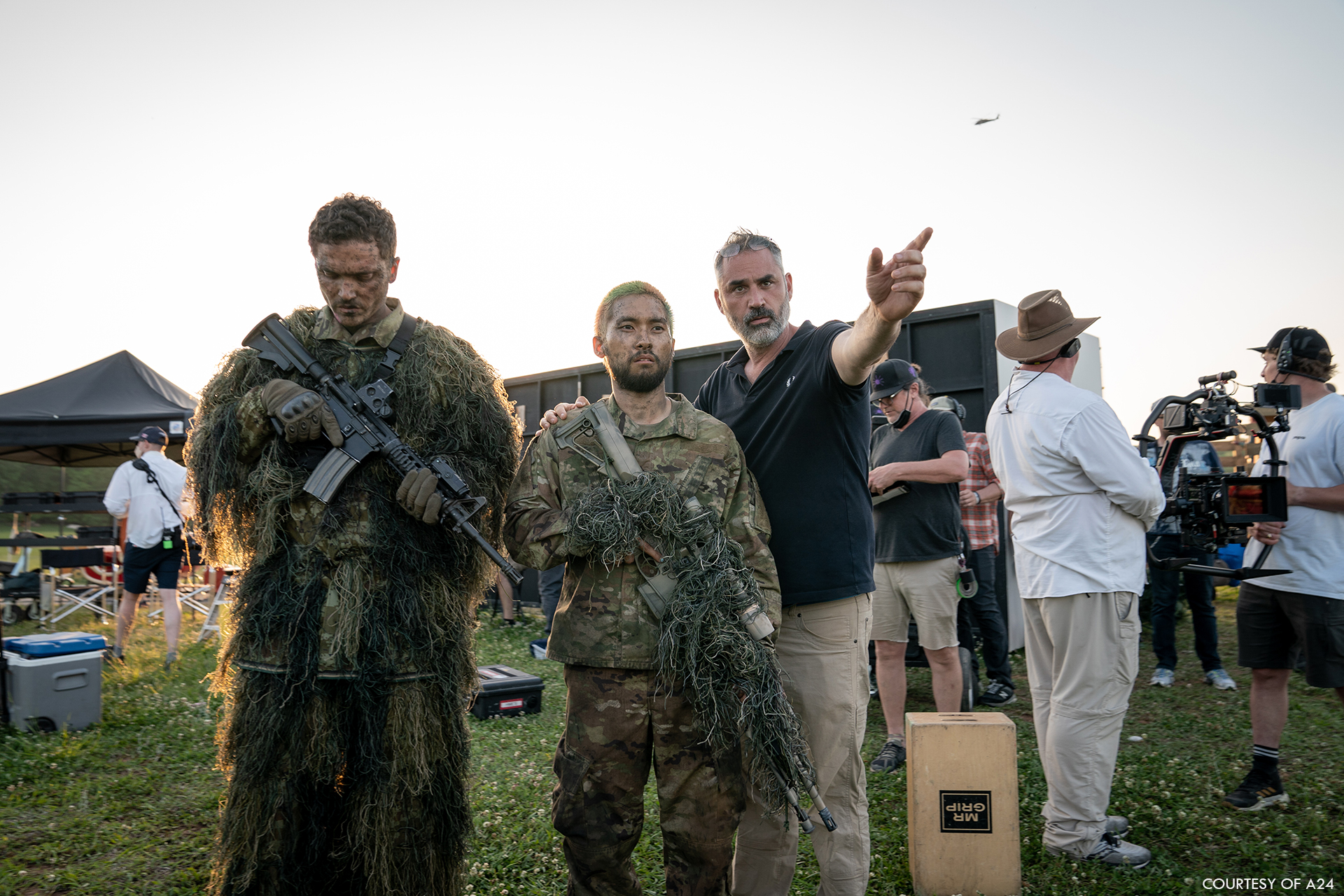
How did you organize the work with your VFX Producer?
There was a lot of VFX work across the show and with only a relatively small team. Michelle Rose and I worked to balance everything in the most efficient way possible.
Framestore took on the lion’s share of the work. Anything that would require lots of creative iteration, design, or CG went to them. This included digi doubles, FX sims, environments.
TPO were based at the edit suite and were fantastic for anything with a quick turn around or temps. They took on a lot of the more editorial or 2D tasks, plus TPO became our go-to team for shootouts. They added bullet holes and impacts all over the daytime sequence at the office building and the climax inside the White House.
Finally, FIXFX picked up a lot of the invisible cleanup work. We had the usual cleanup tasks, but also things you might not even think of. FIXFX were great at those subtle, invisible, world building moments – like removing pedestrians and vehicles, adding an eerie emptiness throughout the film. We also removed planes from the sky as we felt it would be a no fly zone.
Of course, as is the case with all films, plans change and the edit is constantly in flux. Alex is always coming up with new ideas, so we were all kept on our toes!
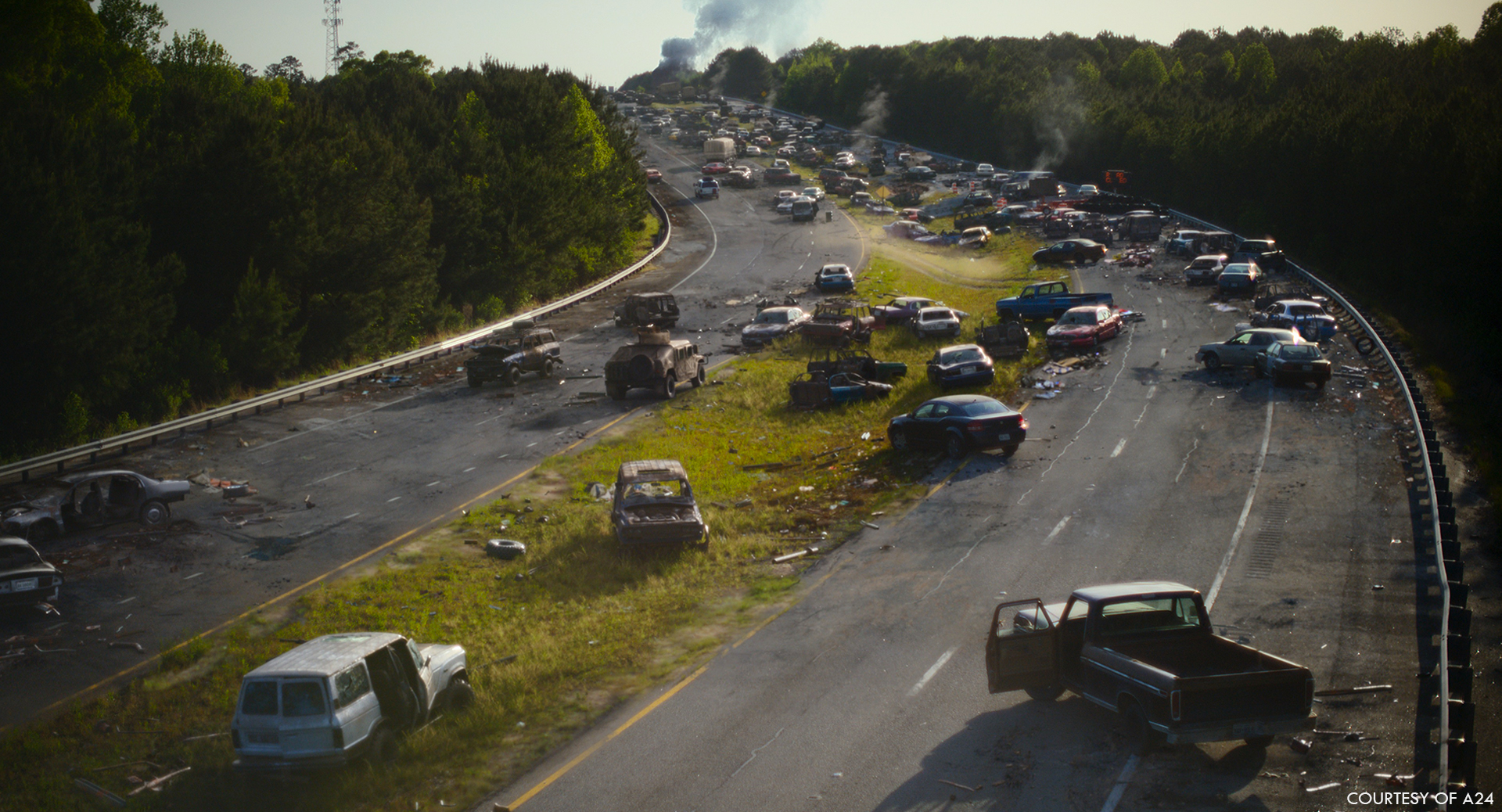
What is the your role on set and how do you work with other departments?
The shoot took place in Atlanta towards the end of the COVID protocols, which allowed us much more face to face interaction between departments. We were all based in the same production office, which really helped collaboration.
Alex and Rob (Hardy, Cinematographer) like to shoot fast. There are always multiple cameras shooting, in a very organic way. Obviously, preparation and planning are vital, but they are also cautious of tunnel vision. No one wants to get too fixated on the plans and miss something fantastic or unexpected.
Therefore VFX needed to be flexible. Throughout the shoot, we often found plans, staging, shots or methodologies changed. Some practical effects didn’t work, others worked better than expected. Michelle and I were constantly re-evaluating and re-strategising, adapting to the natural flow of the production.
On set, Michelle and I worked with VFX Supervisor Chris Zeh. Chris is a seasoned member of the Framestore team and went on to act as our Compositing Supervisor in post. Having continuity between the shoot and the studio working on the final VFX was hugely beneficial. By being on set, Chris took a lot of knowledge into post and built up a valuable early relationship with the team.
Can you elaborate on the process of integrating invisible visual effects to enhance the cinematic experience while maintaining realism?
This is a war film. We wanted to approach that subject with as much respect and authenticity as possible. The intention was never to glamourise war – in fact, from a VFX perspective, we steered away from ‘cinema’ as much as possible specifically to avoid exactly that.
Any references we used came from real world footage. We deliberately avoided looking at other films for inspiration. As a strict rule, our references came from news footage, documentaries, ammunition tests – anything real.
For each visual effect, we sourced a number of references and presented them to Alex. He chose his favourites, based on what best served the story. Those became our anchors in VFX. We called this process “casting” our effects.
From there, the team meticulously analysed and recreated the references to integrate into our shots. We would study the references and ask “what makes this so shocking?” or “how can we get our shot to feel like this?”. It was a real, frame-by-frame, under-a-microscope style process.
It was difficult – you’re looking at real events and real people, which can be very distressing – but, at the same time, we wanted to be respectful and truthful. We took that very seriously.
How did you approach the challenge of seamlessly blending CGI elements with live-action footage?
Rob always selects really beautiful lenses, with a lot of character. That really helps us in VFX. Sure, it makes compositing harder, but once you get there everything feels so more whole. It helps unify the VFX and photography.
On this show, because the photographic language was so distinctive, we really tried to recreate it in our VFX shots.
For example, on our rare full CG shots, we made sure our digital cameras matched Rob’s camera and lens package. Once we’d made our lens selection, we used the grids for the specific lens to recreate the aberration, bokeh, distortion, vignetting. We then found similar shots captured with it in Rob’s photography and took into account how he operated with that lens/camera. How was it mounted? How was it rigged? What aperture was it shot at?
All of that fed into the VFX work, to try and seamlessly hide full CG shots among plate photography. Hopefully it worked!
What specific techniques were employed to create the illusion of invisible visual effects in scenes where characters interact with CGI elements or environments?
We relied on interaction at both the beginning and end of the process.
Firstly, we always tried to have something physical on set for the actors and crew to interact with. That way, anything we add in VFX is another layer on top of reality.
Secondly, when adding something CG, we’d look for ways to have that element interact with the plate too.
For example, there’s a shot in the golf course scene where a body is run over by a car. It’s very quick, but really shocking.
On set, we had a mannequin for everyone to interact with. It gave our stunt driver something to steer towards, our cast something to react to and our cinematographer something to light and frame up on. However, the mannequin lacked weight, it moved unnaturally and always looked like we’d hit something plastic. So, in VFX we painted that mannequin out and replaced it with a digidouble.
As with all things, we first looked for references. The aim with every shot was unflinching realism, so we needed to know what “real” looked like. We found harrowing footage of accidents and studied them for weight, movement, impact.
Then, we worked with our MoCap Performers, Ace Ruele and Jordan Dumaurier, to get a first pass performance. They captured a limp body rolling which helped us with human weight and physicality. Our animation team, led by Max Solomon, then animated on top of that performance.
The challenge then became integrating that CG element into the shot – which is the second type of interaction.
For example, we adjusted the movement of the plate car (tracking, animating and reprojected) to interact with the heavier human body. For example: it bumps higher, the suspension responds differently. We also added dust and dirt to the road, for more interaction.
It’s a very quick shot, but gets a strong reaction. I think that’s the surprise and also because it feels uncomfortably realistic.
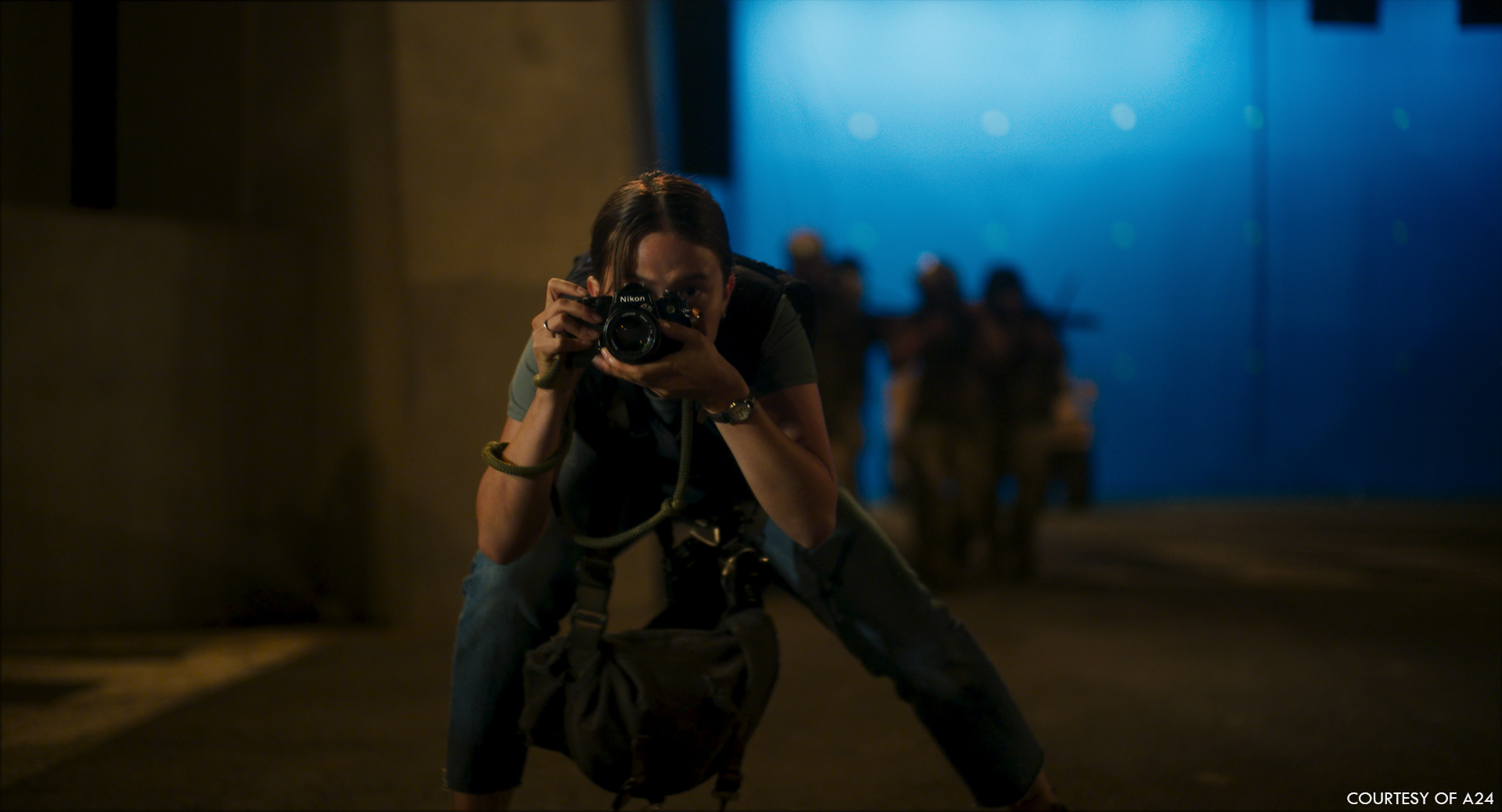
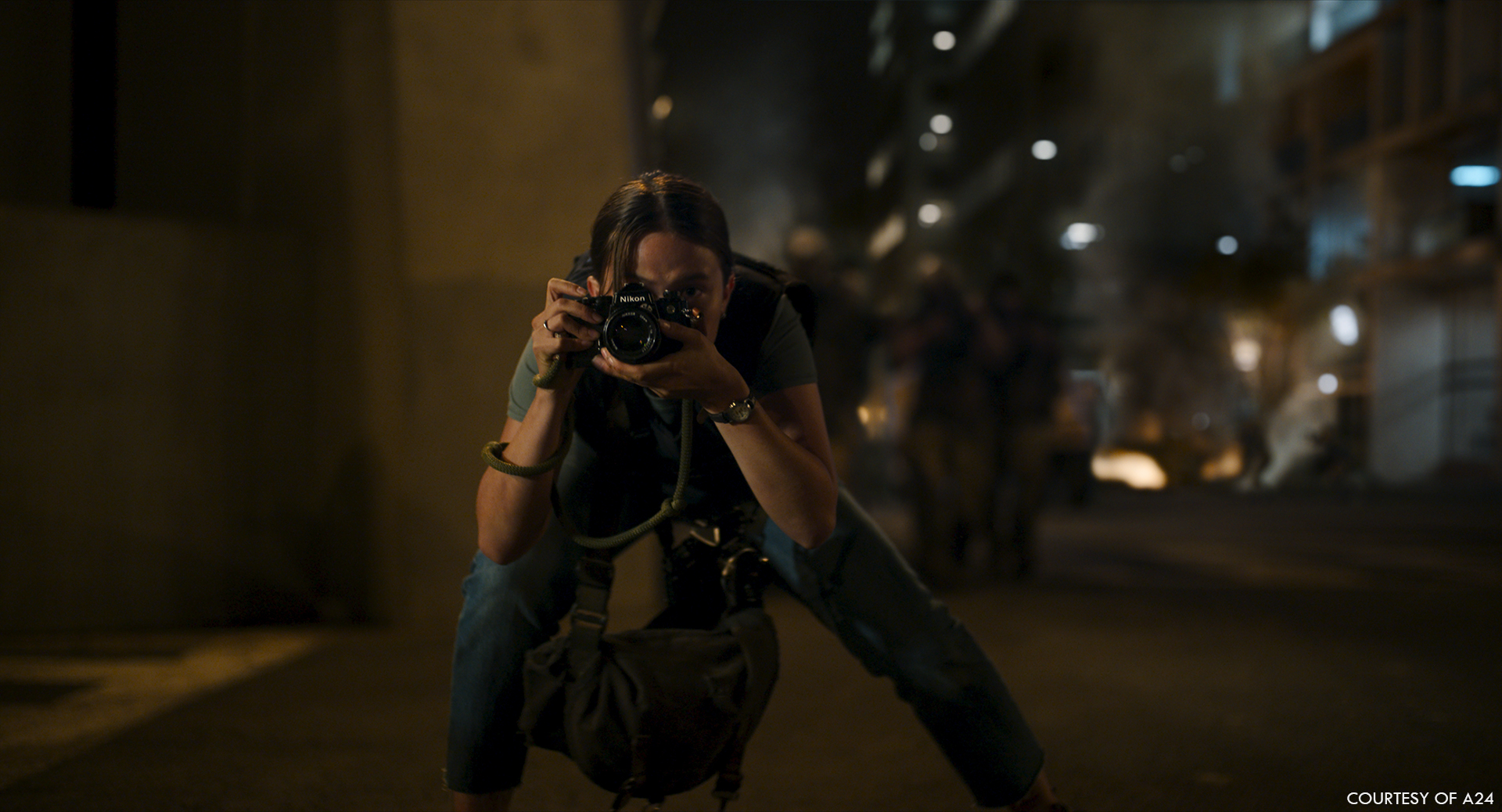
Were there any particularly challenging sequences where the use of invisible visual effects played a crucial role, and if so, how were they overcome?
I think most shows have invisible VFX. Every project nowadays has hundreds of shots that you’d never even think of – cleanup work, wig fixes, getting rid of crew, covering billboards, that sort of work. If you asked an audience member to go through a film and point out every VFX shot, I reckon more than half would go undetected.
The hardest “invisible” VFX are the visible ones. It’s easy to make something invisible when it’s out of focus in the deep background and no one’s looking at it. The real challenge is putting something in the middle of frame, pointing the audience’s attention straight at it, encouraging them to look right at it but not letting it take them out of the story.
That was the hardest part of this project for sure. We had a lot of war torn imagery and desolation. Obviously, you want the audience to see that stuff. They need to register it, but not be distracted by it. That’s a fine line to walk – large enough to have an emotional effect, but not so large as to feel fake. It took a lot of restraint and taste. Alex was really great at threading that needle.
How did you approach the task of recreating iconic landmarks of New York and Washington while the shooting took place in Atlanta?
A few months before shooting, we flew to Washington DC. We went out one night and walked from the Lincoln Memorial to the White House – taking lots of photographs and discussing sequences, staging, troop movements.
From there, we travelled back to Atlanta and locations began scouting for places that could play as DC. Atlanta has a lot of incredible locations, don’t get me wrong, but we couldn’t find anything that worked for Washington DC.
We came close with one option, but it was in the heart of the city – we were shooting in the middle of the night, with gun fire, shouting, explosions, traffic closed off, tanks tearing up tarmac. Logistically, it would have been a nightmare. In order to get permission to shoot there would have required lots of creative compromises.
Instead, we pivoted our approach towards VFX and moved to a parking lot at Stone Mountain.We had three partial builds in the Yellow Daisy Parking lot: The Lincoln Memorial, 17th Street and Pennsylvania Avenue.
17th Street and Pennsylvania Avenue were single intersections, with road markings, pavements, streetlights and the ground floor of each building. The Lincoln Memorial was a short stretch of pavement alongside a patch of grass and trees.
We positioned bluescreen in the key areas (above and into the distance), to extend the set beyond.
Michelle Rose and our lead Wrangler Corey Burks then flew to DC again to capture texture photography and scan as much as possible – passing that data over to Framestore’s environments team, who built the City.
Framestore’s environments team, lead by CG Supervisor Freddy Salazar, then set about painstakingly recreating Washington DC to an extraordinary level.
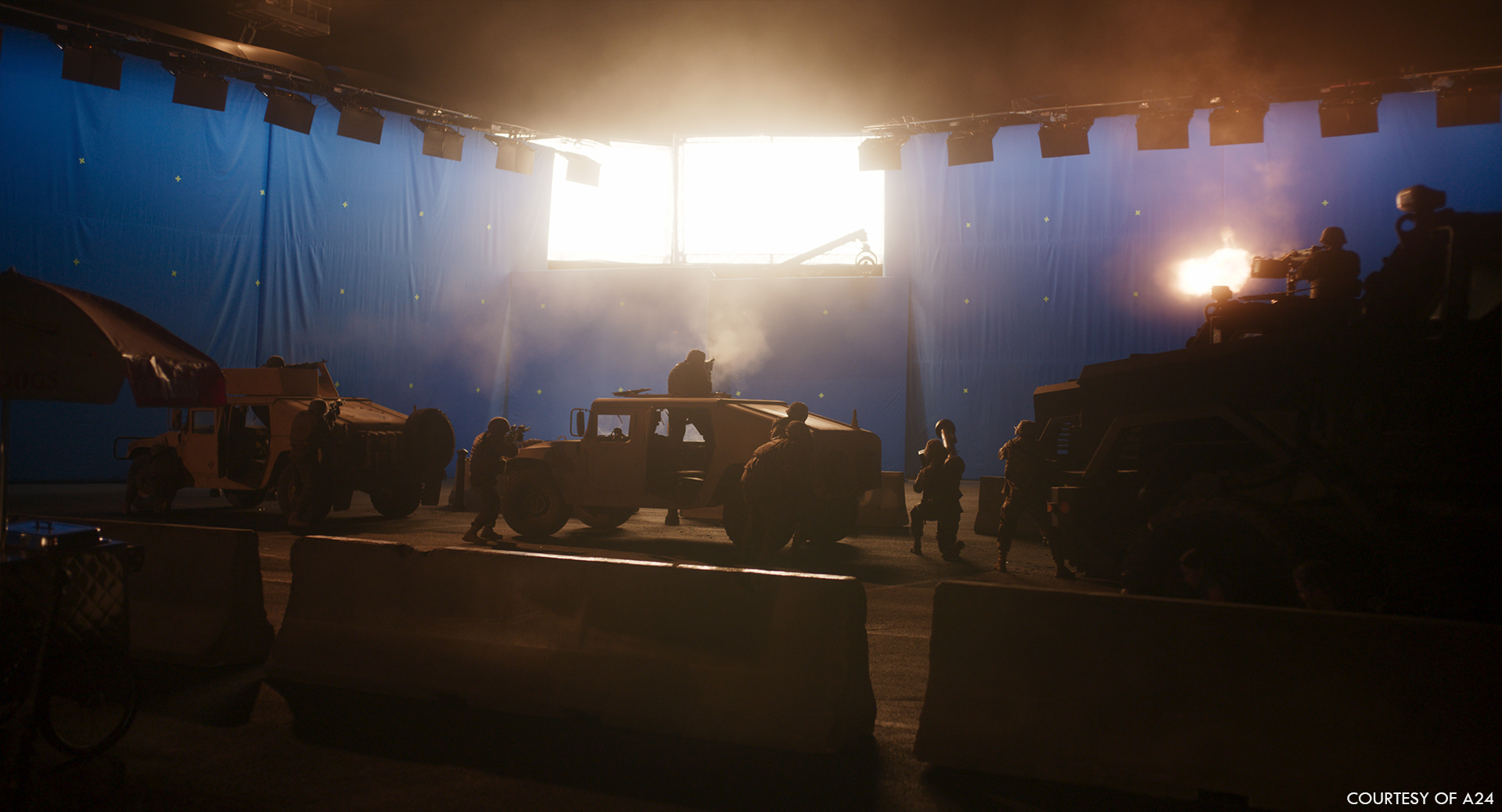
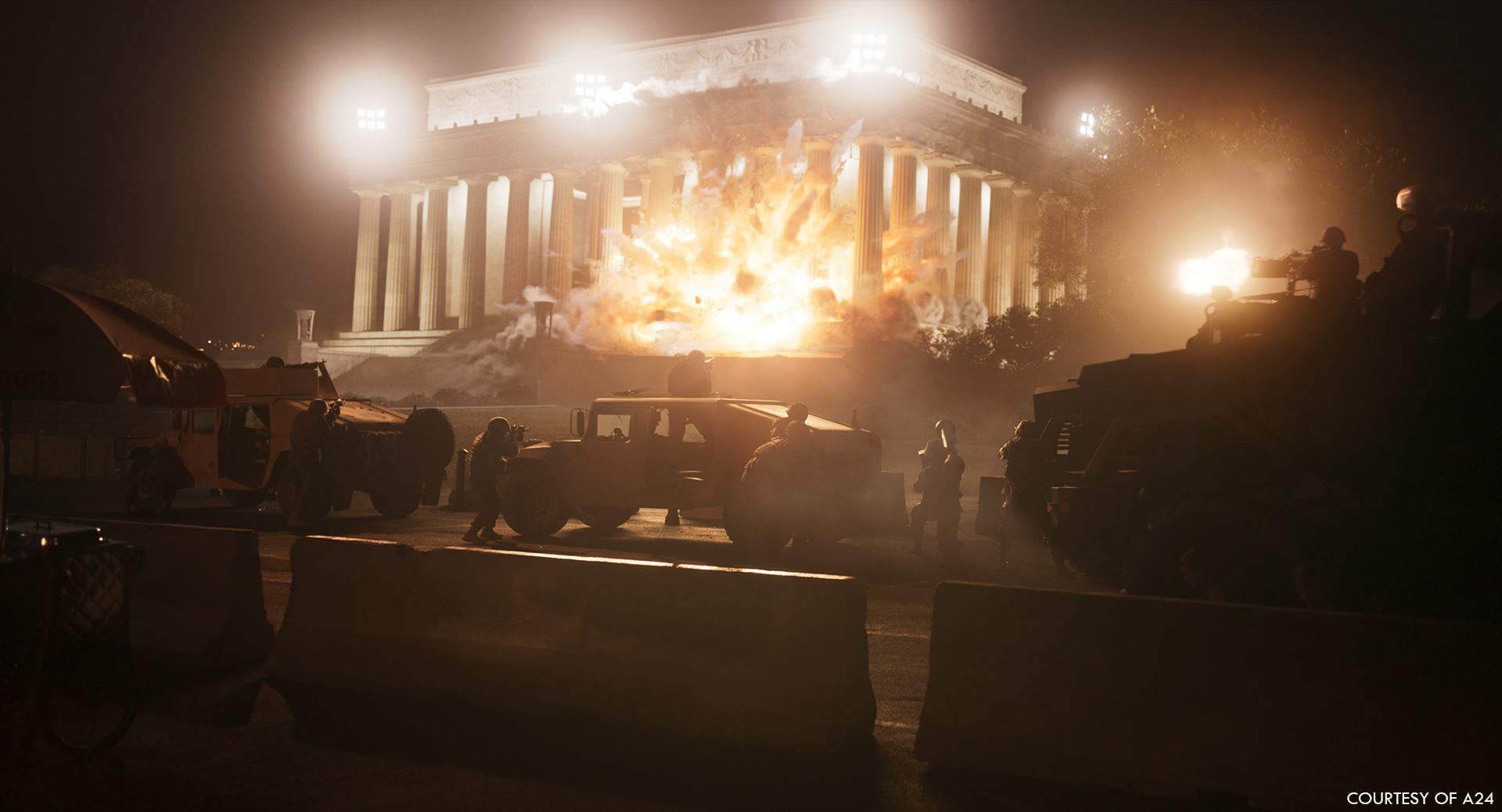
Can you elaborate on the specific techniques used to recreate New York and Washington?
Originally, we planned to shoot plate photography for the Washington DC aerial shots. However, the CG build was looking great, so we embraced it and took the full CG route. This gave more creative flexibility. Filming over Washington DC comes with a lot of restrictions and limitations – especially around the White House.
So, every time there’s a shot in a helicopter over Washington DC, you’re looking at a fully CG city. Every pixel.
Post Production for Civil War was based in London and I remember walking down the street one evening and looking up at the buildings. Every office was slightly different, it had a different layout or interior design. Even subtle differences – like different companies must buy different light bulbs, so some floors have a warmer tint than others. Then there were cranes with blinking red lights in the distance, buildings covered with scaffolding, roadworks. The sort of things which are often overlooked when creating digital cities.
We approached our city with the aim to stuff it with as much life and detail as possible.
Our city’s traffic lights work – they’re programmed to a pattern. Street lamps have variations in bulbs. Every office has an interior – containing desks with monitors and keyboards, whiteboards, posters, potted plants. The offices even have emergency exit signs, air conditioning vents. There are ground floor shops with displays in the windows.
Then there’s the war element: streets have barricades, traffic jams, craters. Some windows and walls have bullet holes and others have been boarded up. Some buildings are on fire, or just smouldering. There are mocap soldiers in skirmishes in alleyways. Police Cars and Humvees race through the streets. There are tank convoys, and MRAPs.
It’s a full, living, breathing, city at war. The care and attention to detail that went into it is astounding. Framestore didn’t just build a City, they built a full warzone – inside and out.
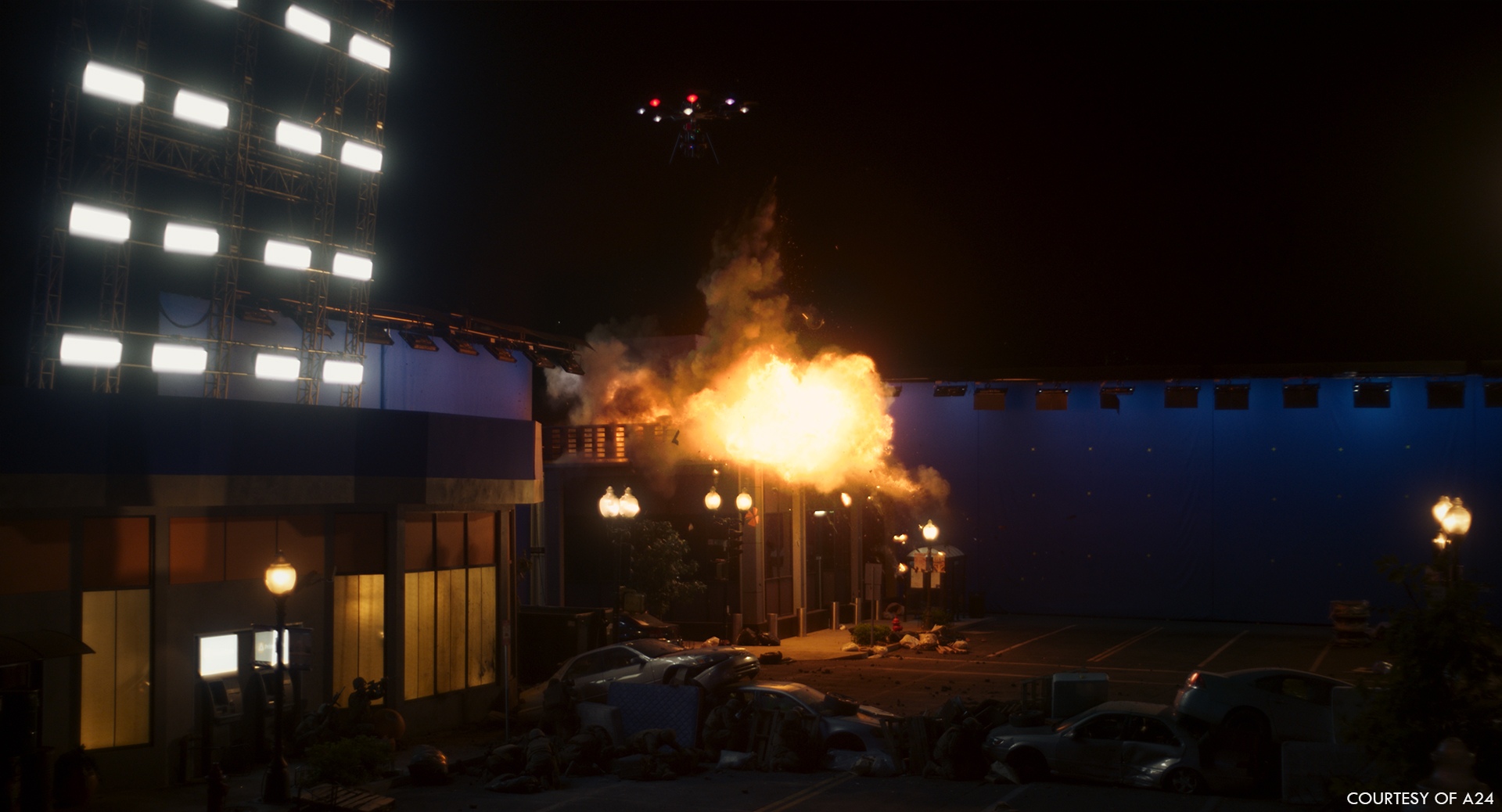
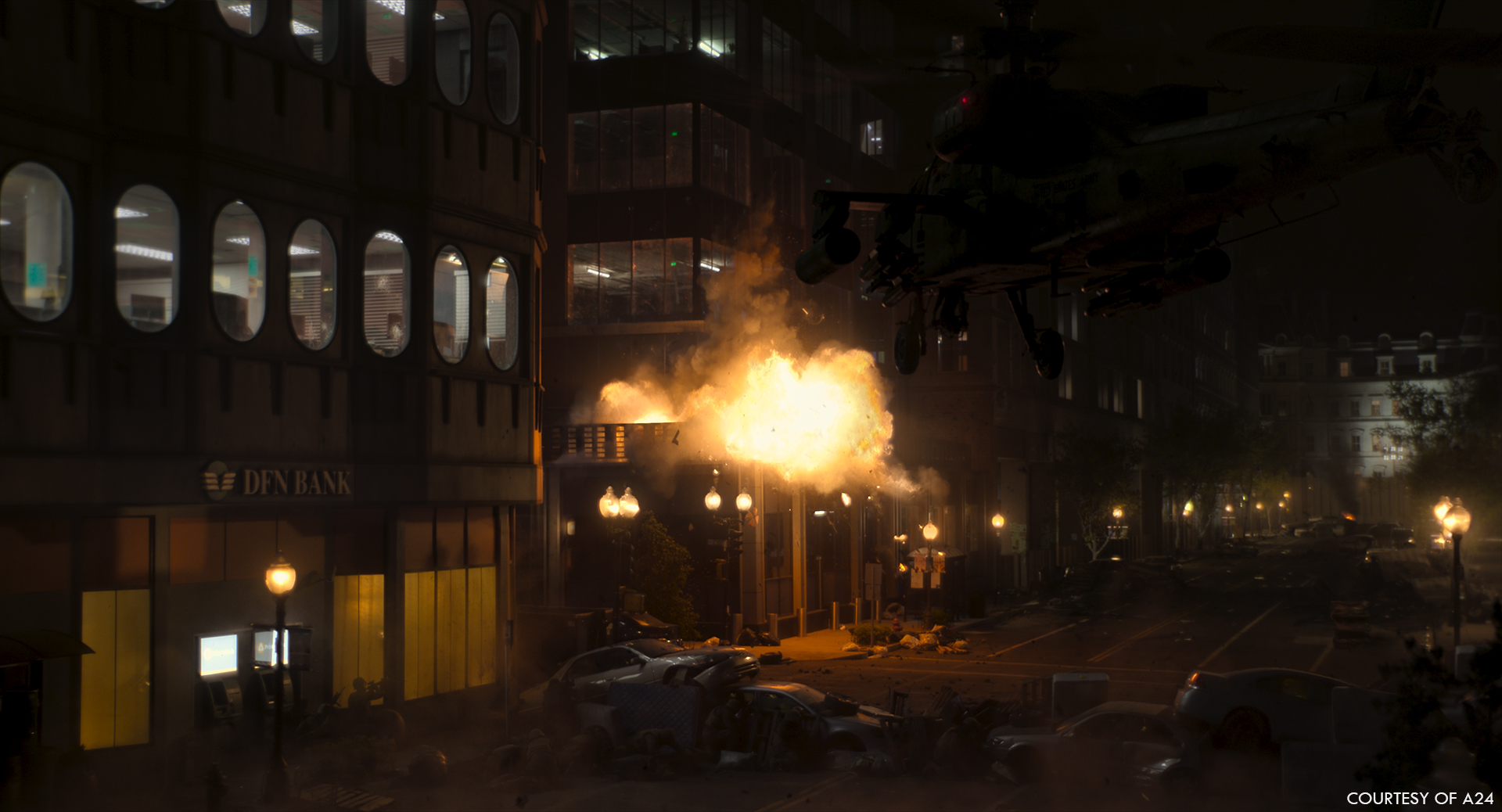
What challenges did the team encounter during the process of transforming Atlanta into these major cities, and how were they overcome?
Sometimes the transformation was straightforward.
Brooklyn, for example, is an intersection in Atlanta with a few establishing shots of Manhattan’s skyline in the distance. Using the internet, we scouted a suitable hero street in Brooklyn and a colleague based in New York took some photographs of the view for us.
Other times, like with Washington DC, it was a bit more involved!
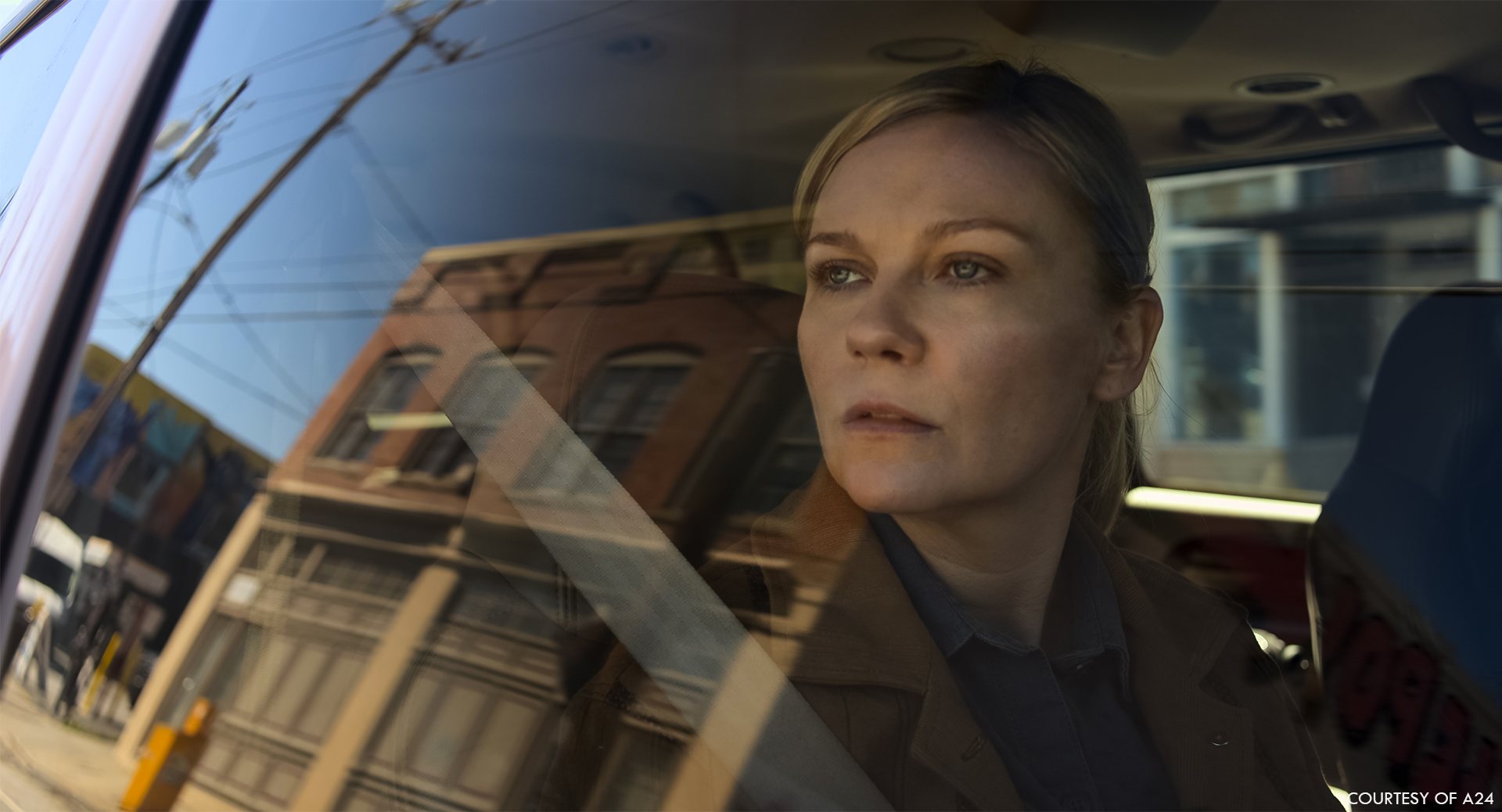
In depicting the White House, what attention to detail was necessary to ensure authenticity while filming in a location significantly different from Washington, D.C.?
There are actually three White Houses in the film. There’s an interior set, built on a stage (used for the corridors and offices). There’s the 75% scale White House at Tyler Perry Studios (used for the shots where characters run up steps and enter the lobby). Finally there’s our CG White House (used for everything else).
Our CG White House is actually slightly to scale too. When Chris Zeh and I came to mark out the route for the stunt Vehicles to drive, we realised the car park was too small. So the grounds of the digital White House and the Eisenhower building are shrunk a little to compensate. We wanted real cars skidding across real tarmac, so that meant shrinking our White House by a tiny amount. We’re talking 5-10%.
Given the complexity of simulating urban environments on screen, what collaborative efforts were undertaken between the visual effects artists and other departments to maintain consistency and believability throughout the production?
There was a lot of collaboration when it came to DC. We had a number of meetings standing in that Yellow Daisy Parking lot – gathered around diagrams and maps.
It was a large build and time was short. Every department worked together to determine where best to focus resources. We took into account where the action was staged and where was the camera pointing, to decide how much set was required.
Luckily, because everything was based on a real city, we always had something to compare to. We could bring up real images of these locations in Washington DC and cling to those.
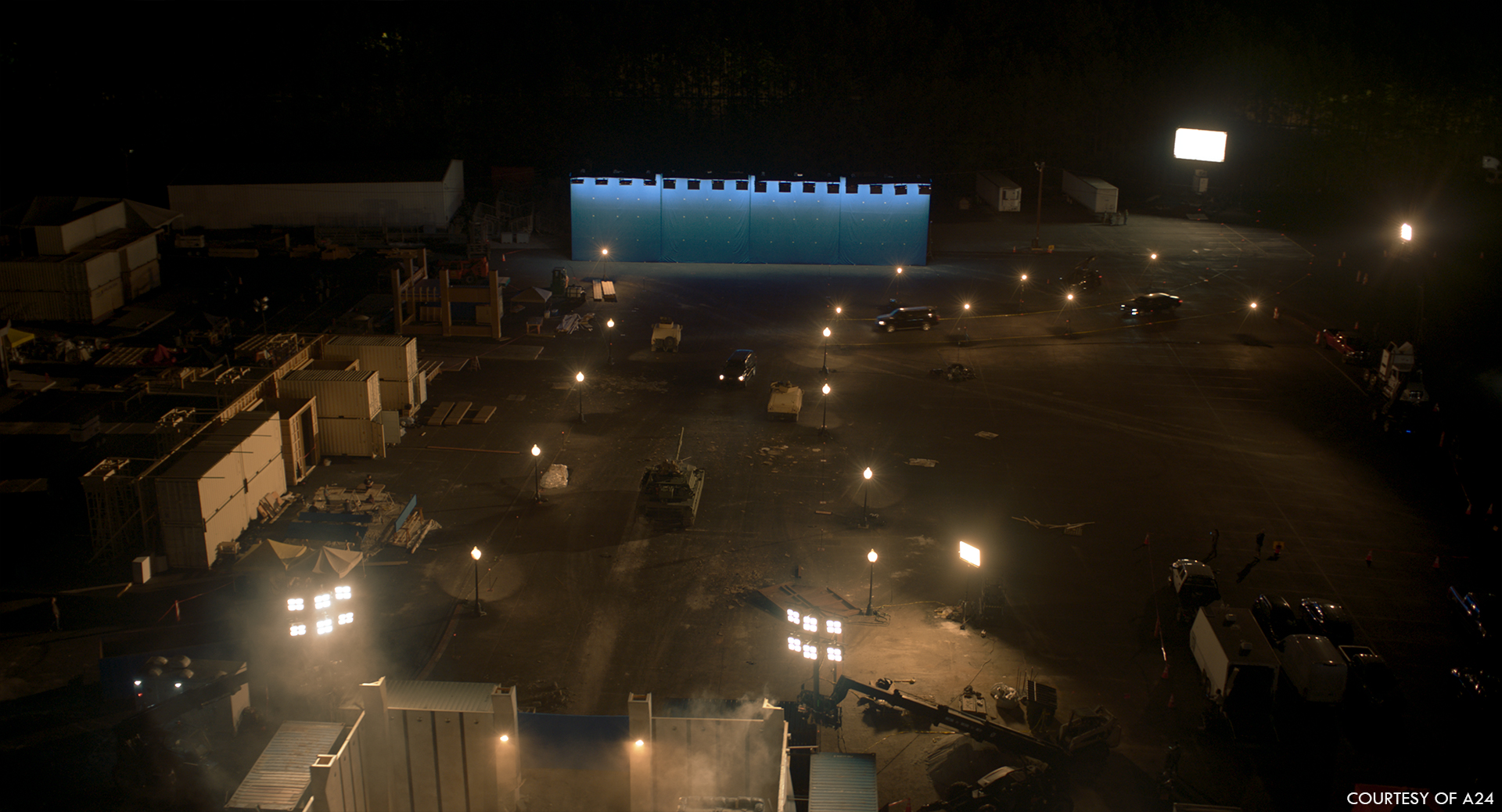
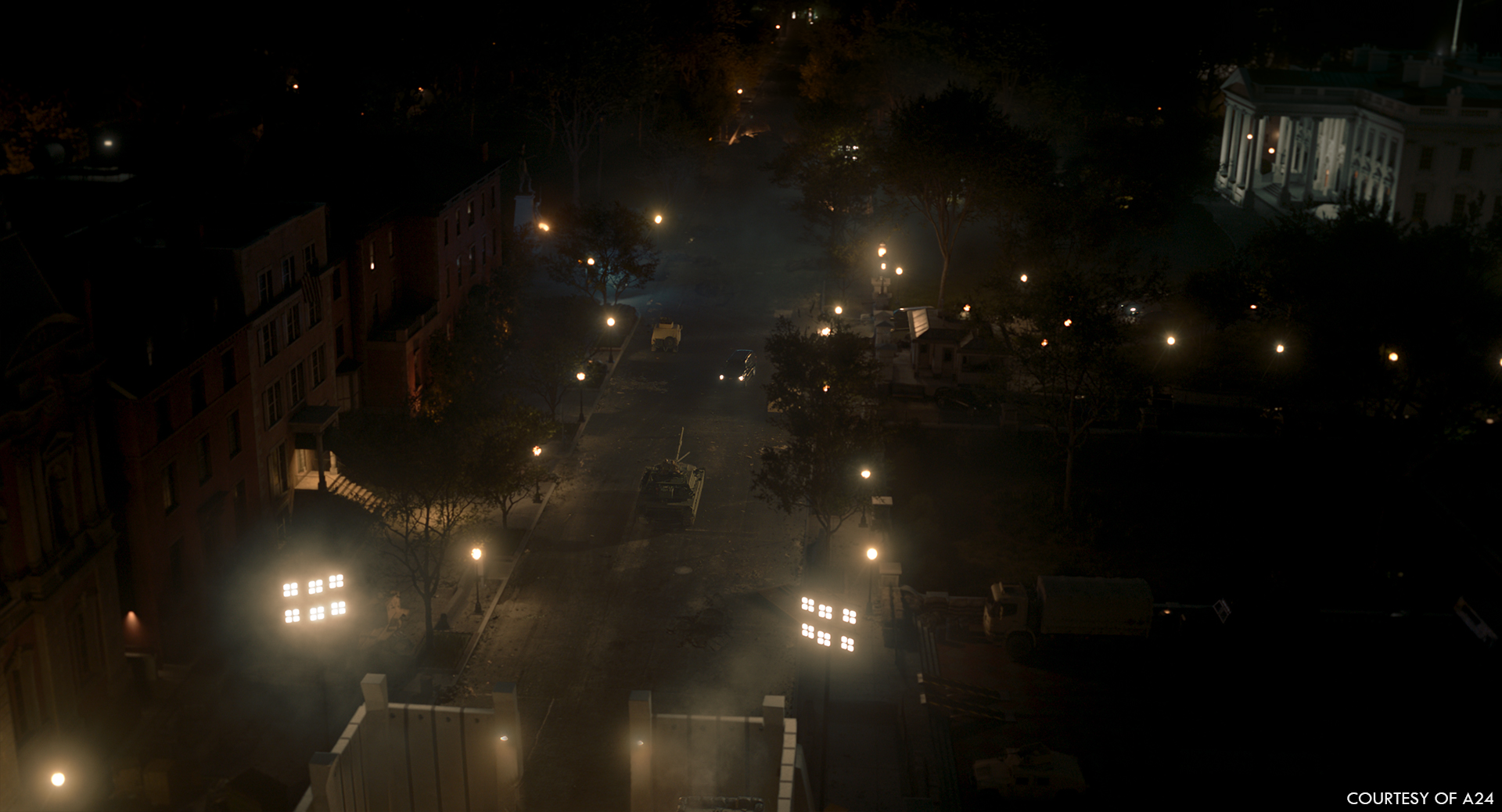
Which location was the most complicate to create?
Washington DC, definitely. While we shot it across three localised sets, the CG asset itself was one whole city.
The hardest part with Washington DC was squeezing more and more realism out of it. Looking for details and ways to ensure the audience believes it’s real.
One of the ways we managed this was to incorporate things you wouldn’t think to do in a CG city – those mundane details and flaws. I mentioned cranes and scaffolding earlier, things like that. One of my favourite instances of this came purely by accident.
On 17th street, there’s a CG building on our intersection with round windows. One day, one of our Environments leads, Matt Chandler, showed me a work in progress and said “Please ignore the round windows, something broke – but we’re going to fix them”.
I was like: “Or… maybe we keep them?”
The beauty of those round windows is they can’t possibly be CG, right? Why would anyone go to the trouble of making round windows for a single building in a CG city? It’s the sort of detail an architect chooses in the 1970s, but would never occur to a VFX team in the 2020s.
I showed Alex and he felt the same way – so they stayed. That mistake is there forever now – sorry Matt, I still love the round windows!
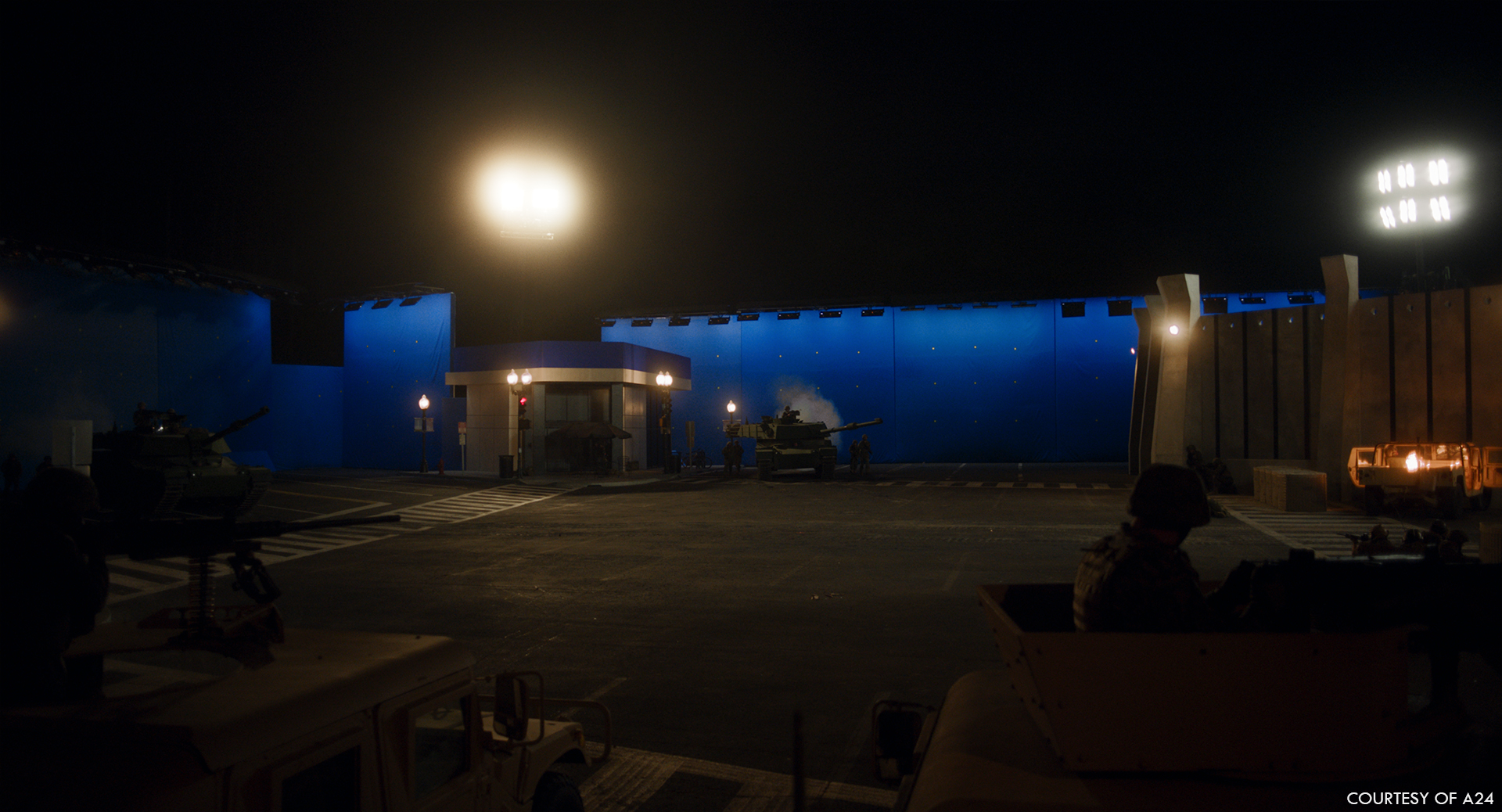
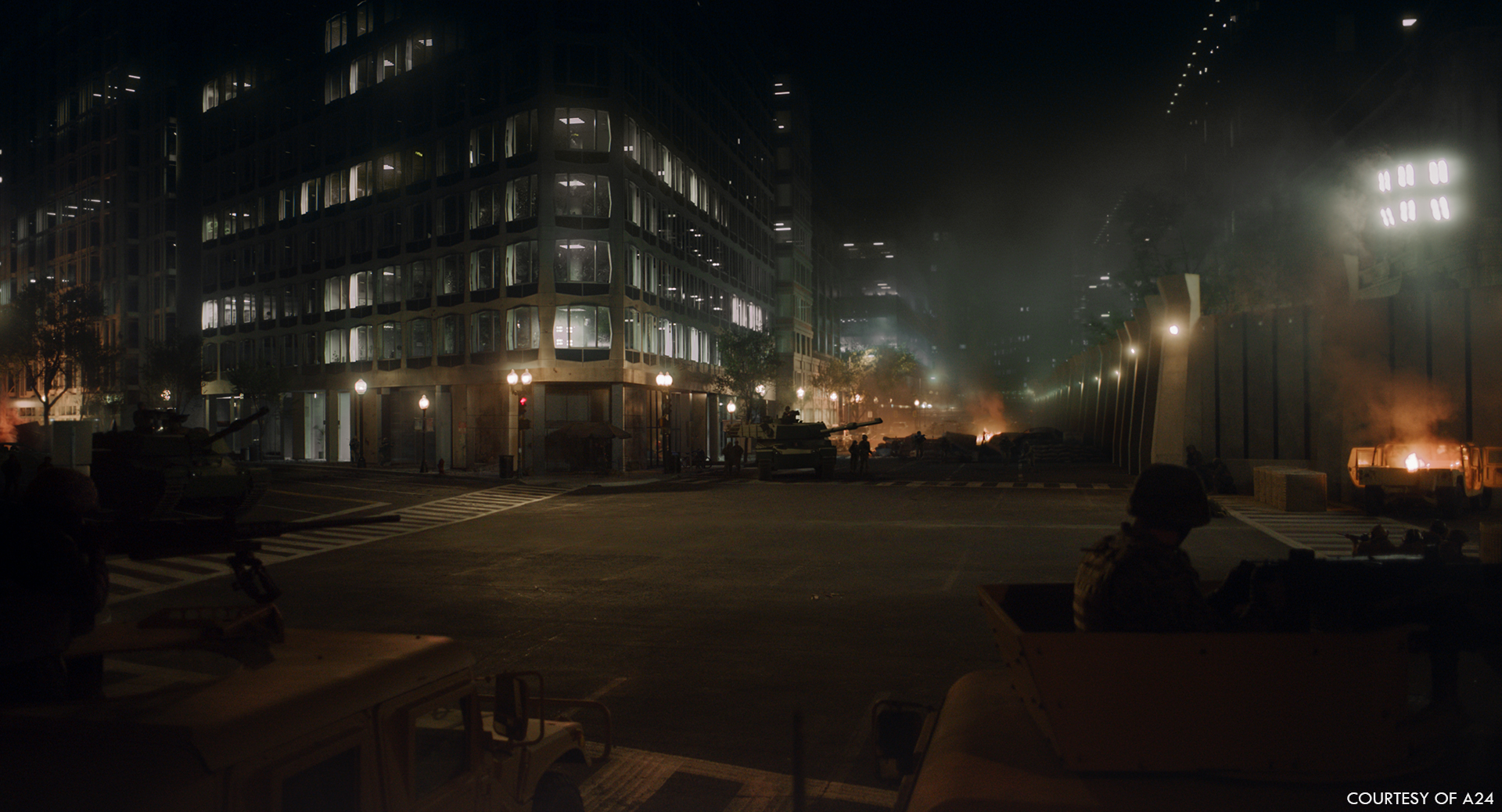
Can you walk us through the key steps involved in designing and animating these vehicles to achieve authenticity on screen?
In my experience, the hardest things to animate are the things we see everyday. Faces, hands, cars. We’re tuned to understand them, which makes our subconscious hyper sensitive.
We tried to make sure all of our vehicles behaved in a realistic way. They never do a stunt that a real pilot or driver couldn’t perform. Even the Apache helicopter on 17th Street (which is probably the most dangerous stunt) a good pilot could have performed. Though they might have blown our set away!
We also tried to have real vehicles in frame as much as possible – to have a genuine reference to match to. For example, at the Western Forces base, we had lots of real tanks, Humvees and MRAPs, but not enough to fill the space. We tried to always use real vehicles in the FG then extend the convoy into the distance with VFX. As soon as you couldn’t tell where the real vehicles stopped and the CG ones began, you were onto a winner.
I think by switching up between CG vehicles and real vehicles, it becomes harder to spot the differences. Sometimes it’s CG, sometimes it’s real, sometimes it’s both. You keep the audience guessing.
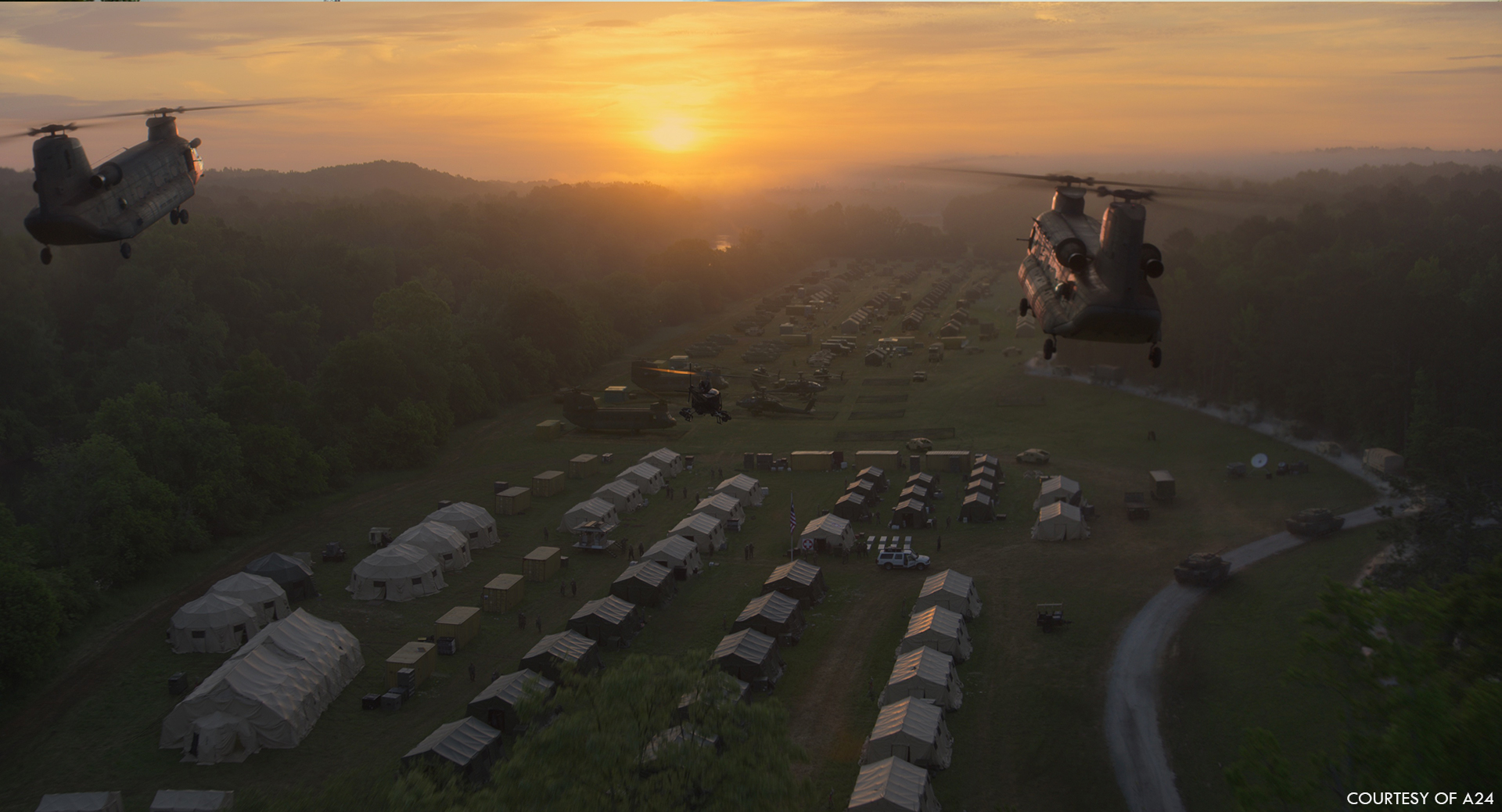
How do you approach the creation of realistic flight sequences for aircraft, helicopters, and other vehicles?
In case I haven’t rambled on about it enough, we were obsessed with references on this film! We found references for everything.
For the full CG Helicopter shots, we took a mixture of stock helicopter footage over Washington DC with real Helicopter shots captured during the shoot.
Fred North and his team shot a number of helicopter plates for Civil War and their work was incredible. The footage was really energetic and beautiful. We used those as a guide for speed, movement and altitude, then referenced the stock photography over Washington DC for framing, lighting, exposure.
When you have a CG camera, the options become infinite. It can go anywhere and do anything – but that wouldn’t have been in keeping with the language of the film. We wanted our CG cameras to feel like they were in the hands of a human operator.
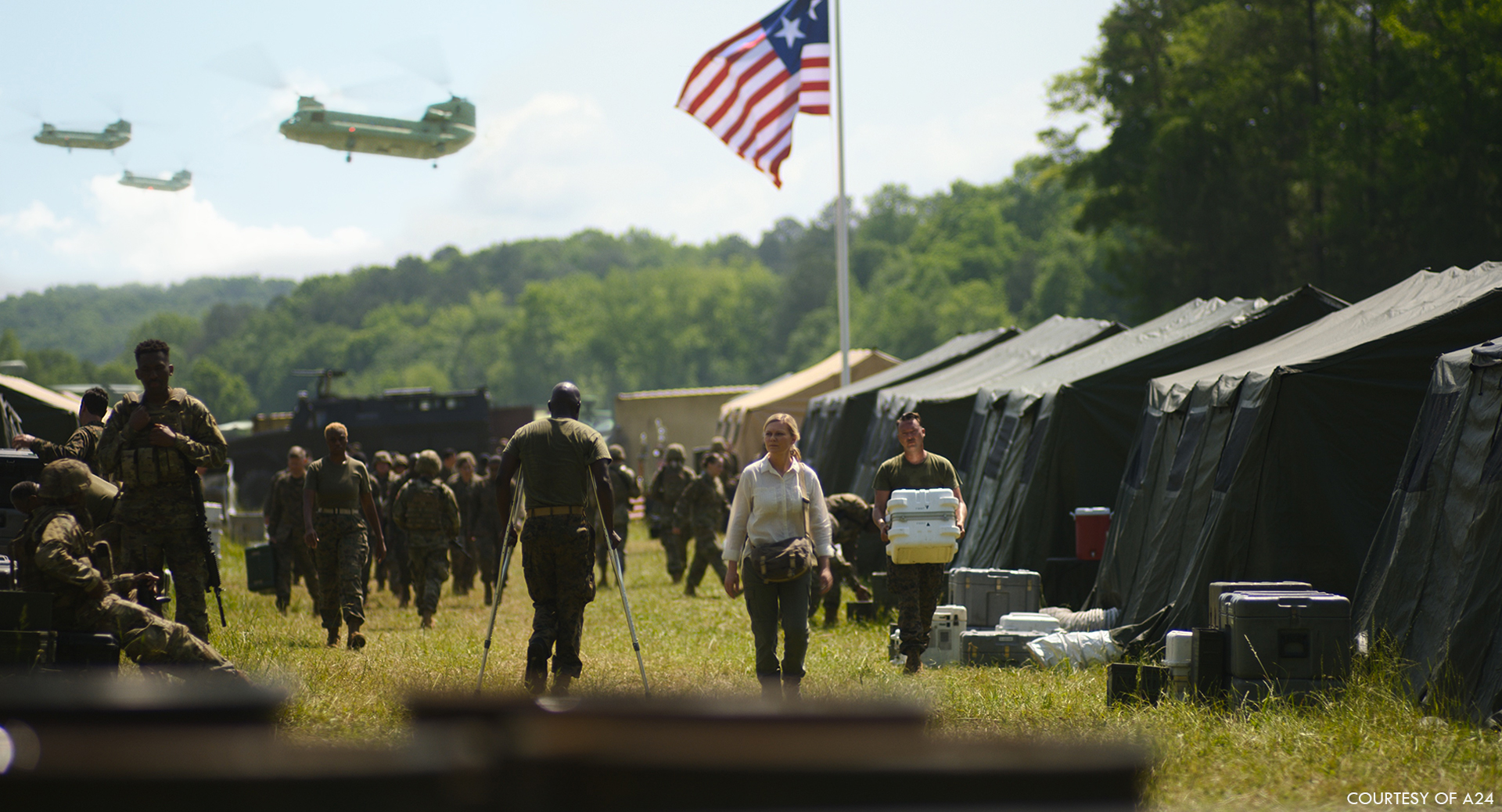
Could you elaborate on the creative process behind crafting the visually stunning forest fire sequence?
I wish I could take credit for this! This is all SFX. J.D Schwalm and his team came up with an incredible forest fire setup.
They safely hid flame trees (a metal tree shaped structure) in clearings through the forest and pumped in smoke which Rob lit with orange light. The embers came from an ember machine mounted to the back of a truck. We drove back and forth down a long stretch of road in a three car convoy. The follow car first (with monitors, which a few of us sat in), followed by the ember truck pumping out embers, followed by the actors in the hero vehicle at the rear.
Honestly, 90% of that sequence is entirely in camera. VFX added tree trunks and branches to the metal flame trees and added CG embers on two shots (where the distance between the vehicles got a bit wide). But other than that, it’s all SFX and in camera. It was magical to film – everyone riding along in the follow vehicle had goosebumps.
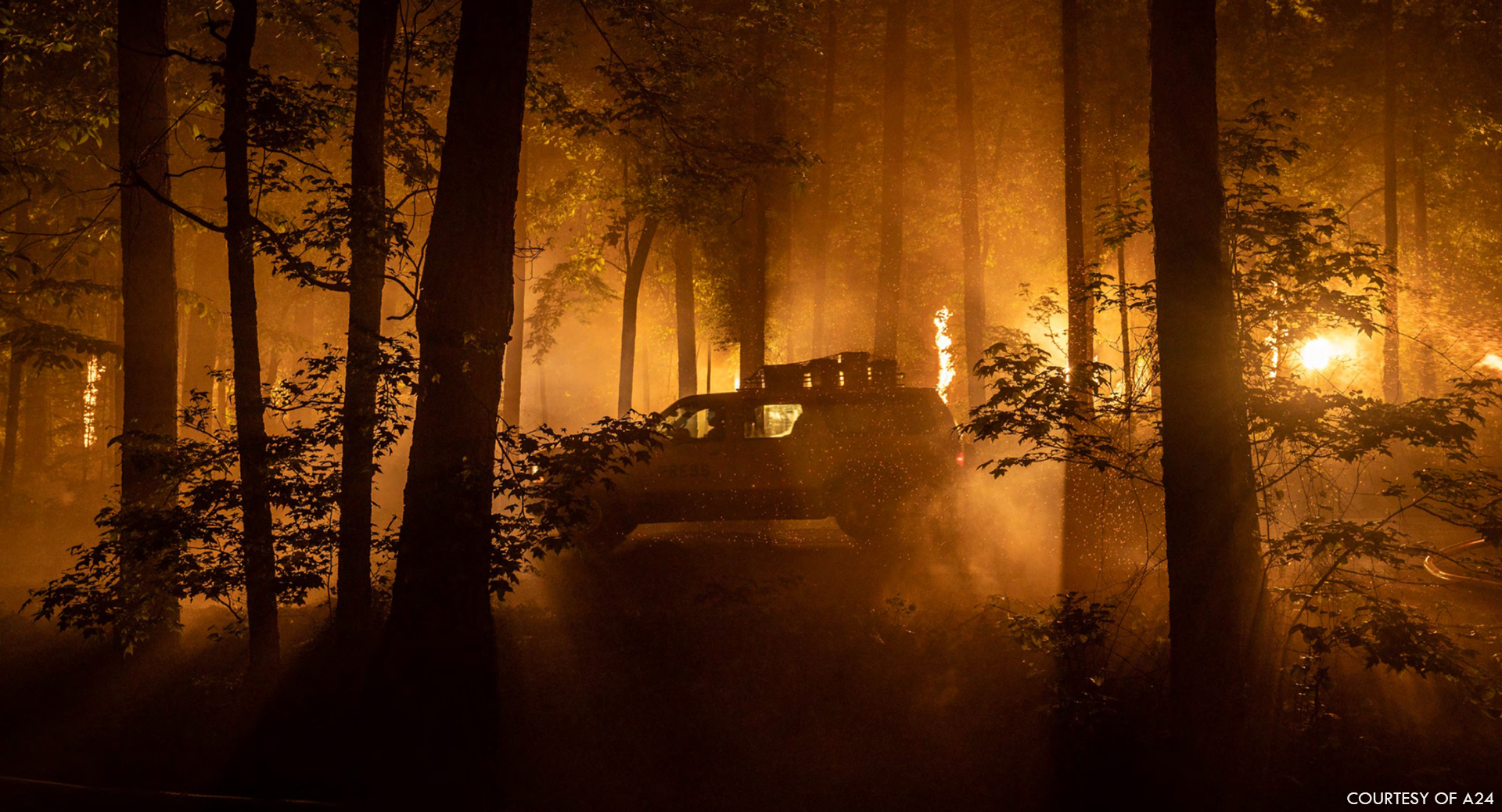
Can you discuss the inspiration behind the visual design choices for the forest fire sequence, including any references drawn from nature or artistic influences?
We looked at real footage in preparation, but again – I wish I could take more credit! It looks great!
There’s an aerial shot at the start of the sequence. That’s plate photography from the helicopter team with Framestore adding the fire in VFX. We found references for that shot and discovered that most forest fires are shaped like a ring. There’s a leading edge of flame at the front, like a wall, but everything behind has burnt out.
I love how that shot turned out, it’s really beautiful.
Were there any memorable moments or scenes from the movie that you found particularly rewarding or challenging to work on from a visual effects standpoint?
I really like the work as a whole. We worked really hard to give it a unified feel. On this film, more than others, I feel the shots blend together into one whole. They complement each other.
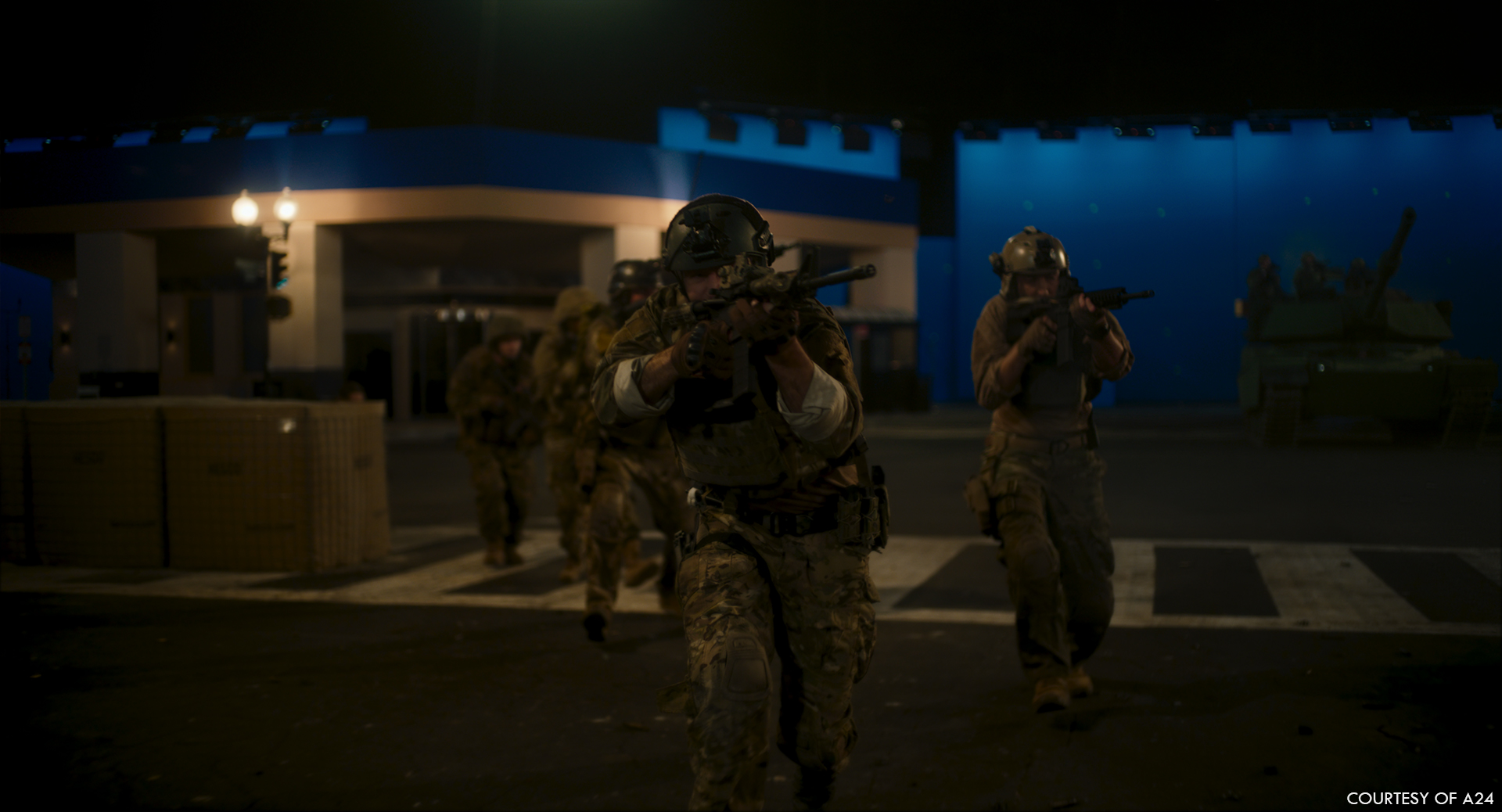
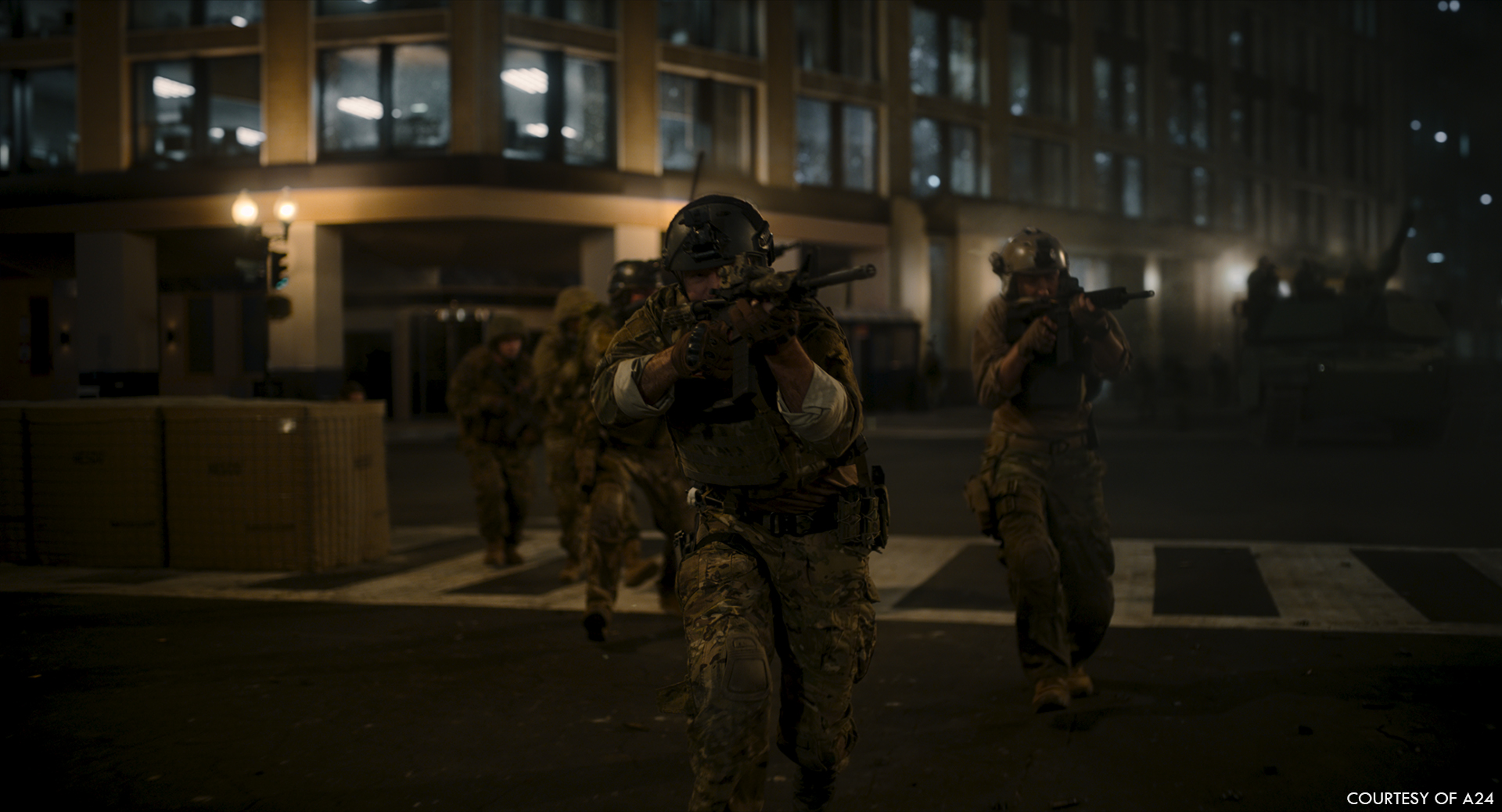
Looking back on the project, what aspects of the visual effects are you most proud of?
We had a really small team – far fewer VFX artists than the average film. However, by being a skeleton crew, we were able to foster a creative environment. It allowed everyone to voice ideas and really invest in the project.
Tricky question, what is your favorite shot or sequence?
It would be easy to say one of the big ones, but often my favourites are the “throwaways”. The ones which I forget are VFX shots – those are the best. I love being fooled by VFX, so the ones that are so seamless they fool me even after I’ve seen them 100 times – those are my favourites.
How long have you worked on this project?
I started towards the end of 2021 and I think we delivered our last shot in June 2023.
What’s the VFX shots count?
Around 1000 shots, split between Framestore, TPO and FIXFX.
What is your next project?
I’m not sure I’m allowed to say yet. Sorry!
What are the four movies that gave you the passion for cinema?
Well, let’s not beat around the bush: Jurassic Park is the best film ever made. That’s not opinion – we all know it’s true. But I also have a fondness for The Marx Brothers, Kevin Costner movies and anything by Aaron Sorkin.
A big thanks for your time.
WANT TO KNOW MORE?
Framestore: Dedicated page about Civil War on Framestore website.
© Vincent Frei – The Art of VFX – 2024






